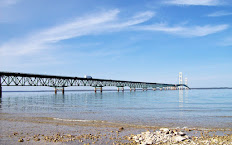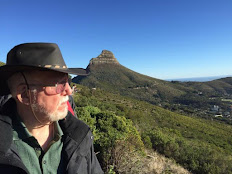 A fall 2006 view of the Salmon Trout River, which flows through an area proposed for Kennecott Minerals' Eagle Project sulfide mine. The river contains a rare population of Coaster Brook Trout. (File photo © 2007 and courtesy lexup at Save the Wild UP.)
A fall 2006 view of the Salmon Trout River, which flows through an area proposed for Kennecott Minerals' Eagle Project sulfide mine. The river contains a rare population of Coaster Brook Trout. (File photo © 2007 and courtesy lexup at Save the Wild UP.)Editor's Note: A contested case hearing challenging mining and groundwater permits for a Kennecott Eagle Minerals Company nickel and copper mine in northern Marquette County began Monday, Apr. 28, in Lansing and is expected to continue for several weeks. The National Wildlife Federation, Huron Mountain Club, Yellow Dog Watershed Preserve and Keweenaw Bay Indian Community are challenging the issuance of these permits by the Michigan Department of Environmental Quality.* This article is the second in a two-part series on plans by Kennecott and other mining companies for future mining in the Upper Peninsula.
By Emily Svenson
The U.P.’s past as a mining district may be making a resurgence as mining companies such as Kennecott, BHP Billiton, and others scope out mineral resources.
Cynthia Pryor, Executive Director of the Yellow Dog Watershed Preserve says, "Kennecott and their parent company Rio Tinto put out a recent press release indicating that they have at least six new sites they may work into mining ventures."
Speaking of the Eagle Project, Pryor says, "This is dangerous. It’s dealing with sulfide ores and uranium, and it’s snowballing. That’s why we’re so focused on this case. Companies are waiting for this case to get cleared up so they can see how the courts handle the situation."
If the State of Michigan gives Kennecott the go ahead with the mine on the Yellow Dog, companies may start swarming the U.P. to tap its vast mineral resources. The map below, courtesy of Save the Wild UP and Northwoods Wilderness Recovery, shows mineral rights and mining plans for the U.P.
Michelle Halley, an attorney for the National Wildlife Federation, says, "The U.P.'s most valuable natural resource is the Great Lakes. The history of sulfide mining demonstrates that it would put the Lakes and their tributaries at risk. Our planning for the U.P.'s future should extend beyond the 10-year horizon and take into account the world's need for fresh water and protect the blessing of it here in the U.P."
Vast Majority of U.S. minerals exported
Pryor says, "Most of the metals extracted today go to feed China’s extensive growth. Rio Tinto and other major mining companies sell their minerals to China."
According to the Associated Press, China recently tried to buy Rio Tinto for $200 billion. BHP Billiton, the world’s largest mining company, also tried to buy Rio, the world’s third largest, for $147.4 billion. Rio rejected both offers. China, Rio Tinto’s biggest customer, is currently boycotting both Rio and BHP Billiton.**
"China's extraordinary appetite for resources has almost single-handedly powered the Australian economy through a downturn in the rest of the developed world," writes John Garnaut of The Sydney Morning Herald, "but the Chinese boycott of BHP and Rio shipments shows the extent of Chinese concerns about the rising market power of the world's largest and third largest miners, which would be greatly magnified if BHP succeeds in acquiring Rio."***
Australia considers China a powerful economic ally.
Paul Campbell, a resident of Calumet and Lac LaBelle, has been involved in the Kennecott Eagle Project as a local citizen. He has been to public DEQ forums and informational meetings and is strongly supportive of any groups that oppose sulfide mining in the U.P. However, he is not affiliated with any group.
"Because of China and India’s emerging economies, precious mineral prices have skyrocketed," Campbell notes. "Kennecott and other mining companies here in the U.P. have responded to China and are taking advantage of the potential to make high dollars for their investors without any regard to the long-term consequences of their actions to the land and people."
Campbell mentions China’s massive air pollution problem as they rapidly industrialize using coal-fired furnaces.
"The documented [air] pollution we get from China here in the U.P. is caused by their cheap, simplistic industrial complex, using coal-fired furnaces. So in reality, the very problematic sulfide ore that will affect our land, as it is being mined, exposed, processed and then shipped to China will also come back to haunt us. Unfortunately, this reminds me of Catch 22," Campbell says. "It is believed by some that China will surpass us as a world power by 2035."
Granholm Town Hall Meeting deemed orchestrated and disappointing
Pryor also commented on a recent Town Hall Meeting with Michigan Governor Jennifer Granholm broadcast from Grand Rapids.
"The meeting was orchestrated to give answers to pre-arranged questions that would enable the Governor the ability to respond to all questions with an upbeat answer." Pryor said.
According to Pryor, Granholm "took the easy way out" by not addressing issues of immediate concern to many citizens.
"She knew I wanted to talk about her vision of the U.P. with the insurgence of all the proposed mines and escalating minerals explorations," Pryor added, "but she chose to ignore the question and the concern."
According to a report by Ted Roelofs of The Grand Rapids Press, Governor Granholm believes she will be able to improve Michigan’s economy by developing jobs in medicine and biotechnology, job retraining and providing incentives to encourage alternative and renewable energy development.
"She pointed to Sweden as a possible model for Michigan, noting it has created 400,000 jobs in renewable and alternative energy. Sweden, like Michigan, has about 10 million people, enjoys a long coastline, and has abundant forests," Roelofs writes.****
Although Granholm says she wants to provide incentives for renewable energy, she does not seem to resist the development of mines in the U.P., as long as companies follow the mining rules recently put into place in Michigan.
We live in a beautiful place
Marquette was listed in the April 2008 issue of Outdoor Life magazine as #7 in the 200 best towns to live in the U.S. for hunters and anglers. Marquette was noted for its natural beauty and outdoor adventure opportunities.*****
So often, people from other places, such as Chicago or Green Bay, say they wish they could live in the U.P. because of its natural beauty and recreational opportunities, such as skiing, camping, and snowmobiling. If mining makes a major resurgence, will the U.P. still be a vacation destination? Will it still have the natural beauty that draws people here and makes them envious of those fortunate enough to live here year round? Residents of the U.P. are so lucky to be surrounded by clean air and water; this heritage needs to be preserved for future generations.
Campbell asks, "What pathway do we want? Will we get leaders who lead and who will show respect for the land and people to bring us together? If we don’t, what will the future hold for our Children, our Precious Minerals?"
Notes:
* See updates on the contested case hearing on Save the Wild UP.
** See the Feb. 2008 Associated Press article, "Rio Tinto Rejects $147.4. Billion Take-Over Bid."
*** See "China locks out BHP and Rio ore." The Sydney Morning Herald. March
18, 2008.
**** See "Granholm’s Town Hall Meeting Frustrates Attendees." The Grand Rapids Press. March 20, 2008.
***** See "Paradise Found." Outdoor Life Magazine. April 2008.
Visit the Yellow Dog Watershed Preserve Web site for a slide show of photos of the area threatened by the Eagle Project.
Emily Svenson, the author of this article, is a free lance writer and Keweenaw Now visiting reporter. The first article in this series, "Will Kennecott mine the Yellow Dog Plains?" appeared on Keweenaw Now on Earth Day, Apr. 22, 2008.



















































































































1 comment:
This is an excellent article! Well written and informative. I hope to see more articles from Ms. Svenson
Post a Comment